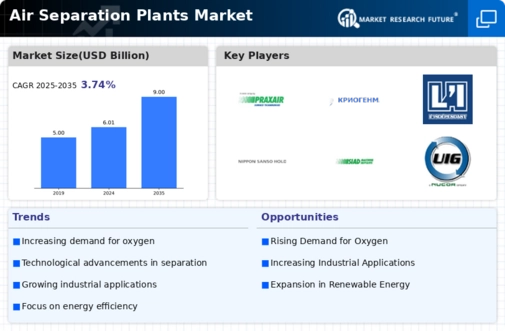Top Industry Leaders in the Air Separation Plant Market

*Disclaimer: List of key companies in no particular order
Top listed companies in the air separation plants industry are:
- Linde AG
- Air Liquide SA
- Praxair Inc.
- Air Products and Chemicals Inc.
- Taiyo Nippon Sanso Corporation
- Messer Group GmbH
- Universal Industrial Gases
- Enerflex Ltd.
- Technex Ltd.
- Gas Engineering LLC., etc
Competitive Landscape of Air Separation Plants Market: Navigating the Nitrogen and Oxygen Winds
The global air separation plants (ASPs) market is a behemoth, churning out vital gases like nitrogen and oxygen for diverse industries ranging from healthcare and steel production to electronics and wastewater treatment. This landscape pulsates with fierce competition, where established titans clash with nimble innovators, all vying for a larger share of the pie.
Key Players and Strategies:
- Industry Dominators: Leading the pack are giants like Air Liquide, Linde Group, Messer, and Praxair. These established players leverage their extensive global networks, robust technological expertise, and diversified product portfolios to capture significant market share. Their strategies center around geographical expansion, continuous R&D investments, and strategic acquisitions to bolster their reach and capabilities. For example, Air Liquide's acquisition of Cryostar strengthens its foothold in cryogenic solutions, while Linde Group's focus on energy efficiency through membrane-based separation technologies helps them cater to cost-conscious customers.
- Regional Champions: Local players like IHI Ionbond (Switzerland), CO2 Solutions (Canada), and PCI (China) hold sway in their respective regions. They capitalize on their deep regional understanding, agile operations, and competitive pricing to carve out a niche. PCI's success in China, built upon cost-effective modular ASPs, exemplifies this approach.
- Technological Trailblazers: Emerging players like Air Products & Chemicals and Carbon Capture Inc. are disrupting the scene with innovative technologies. Carbon Capture's focus on capturing CO2 from the air separation process, thereby producing "blue" hydrogen, aligns with sustainability goals and opens new revenue streams. Air Products' efforts in developing advanced on-site oxygen generation solutions catering to remote locations showcase their focus on niche markets.
Market Share Analysis: Beyond Tonnes of Oxygen
Determining market share in the ASPs market goes beyond simply measuring the tons of oxygen produced. Here are key factors to consider:
- Revenue Generated: While overall production volume provides a broad picture, understanding the revenue generated from different segments like industrial gases, medical oxygen, and on-site solutions paints a more accurate picture of financial strength.
- Geographical Footprint: Presence in key regions with high demand, access to raw materials, and established distribution networks contributes significantly to market share.
- Technological Prowess: Companies leading in R&D, holding key patents, and offering cutting-edge solutions like cryogenic optimization or membrane advancements gain an edge.
- Customer Service and Brand Reputation: Delivering reliable supply, efficient after-sales service, and maintaining a strong brand image within diverse industry segments are crucial for market share sustainability.
Emerging Trends: Shaping the Future of Air Separation
Several trends are reshaping the competitive landscape:
- Sustainability Push: Companies are striving for energy-efficient operations, exploring renewable energy sources for power, and looking at carbon capture and utilization technologies to minimize environmental impact.
- Digitalization and Automation: Integrating automation and data analytics into ASPs optimizes performance, reduces downtime, and enables remote monitoring for efficient maintenance.
- Modularization and On-site Solutions: Demand for smaller, modular ASPs for localized oxygen production in remote areas or for specific applications is growing, creating new market opportunities.
- Diversification and Customization: Offering customized gas mixtures, catering to niche applications like food and beverage or pharmaceuticals, and expanding into adjacent service areas like gas management solutions are becoming crucial for growth.
Overall Competitive Scenario: A Dynamic Dance
The ASPs market is a complex symphony of established giants, agile regional players, and innovative disruptors. Success hinges on adapting to evolving customer needs, embracing sustainability initiatives, and continuously innovating in technology and solutions. Companies that can navigate these winds and ride the waves of emerging trends will solidify their position and claim a larger share of the oxygen-rich future of this vital industry
Latest Company Updates:
September 2023- BASF has a new plant to produce oxygen, and nitrogen has gone upstream at the Schwarzheide site. Nearly 40 million euros have been invested in the building of the air separation plant of the French company Air Liquide. As per the data released by the company, CO2-free compressed air will also be offered for BASF in the future. The chemical giant requires these substances to produce battery materials. The plant was constructed in two years on an area of 12,000 square meters – in the near vicinity of BASF's new production facility for high-performance cathode materials. The Chairman of the Board of BASF Schwarzheide, Jürgen Fuchs, said that with the latest air separation plant from Air Liquide, the company will be able to supply the production of cathode materials with technical gases, which are now produced directly on-site, both efficiently and safely, therefore making a vital contribution to securing the future of the site.
In the facility, ambient air is pulled, cleaned, compressed, and cooled. At its core, "cold box": at temperatures of minus 180 to minus 190 degrees, the air gets a liquid state and can, therefore, be broken down more easily.
October 2023- Cummins Inc. disclosed that Cummins Emission Solutions finished its acquisition of two Faurecia commercial vehicle manufacturing plants and their related activities, one in Roermond, Netherlands, and one in Columbus, Indiana (U.S.). Faurecia is a global automotive technology player and company of the FORVIA Group. Cary Chenanda, the Vice President of Cummins Emission Solutions, said that the company disclosed their intent to acquire this portion of Faurecia's business in May of 2023, and the Cummins, Faurecia, and FORVIA teams have put efforts to push this across the finish line in recent months.

